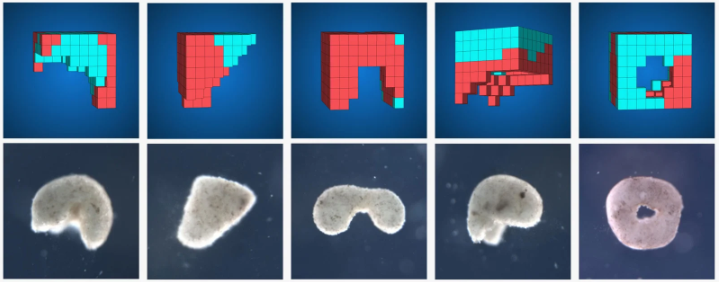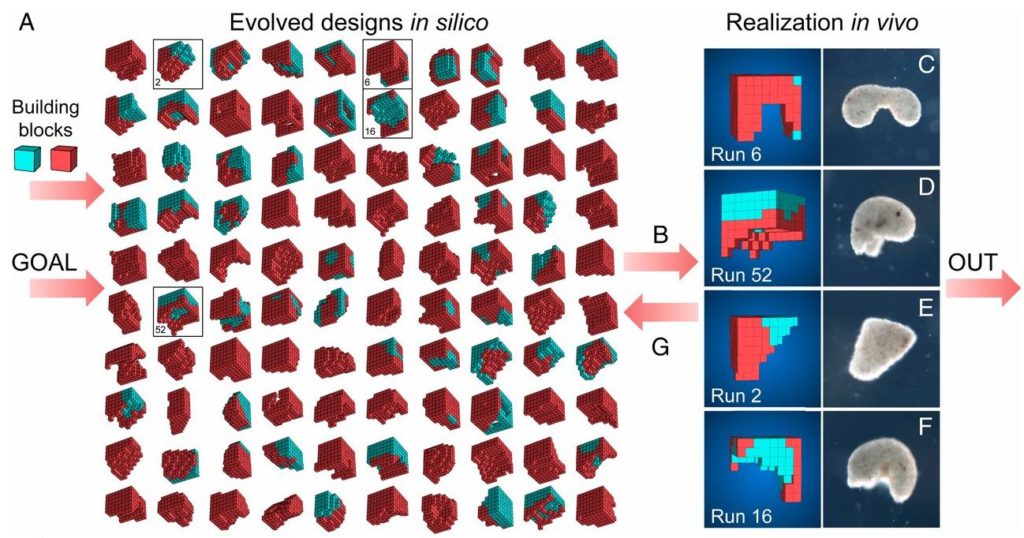Overview
Xenobots are microbots made from biological cells and developed and programmed by a computer. We are literally “talking robots,” which are the first programmable mode of life in the world. Researchers, who were recently created in 2020, used an Evolutionary Algorithm * to construct the xenobots and were successfully able to program and design the modern organism structure. Its name derives from the African clawed frog (Xenopus laevis) whose stem cells for the Xenobots were used as the foundations. [2] [4]
A xenobot is a biological system smaller than 1 millimeter (0.039) “long, compact enough to fly inside human bodies. Every Xenobots consists only of two cell types: the heart cells and the skin cells. The skin cells are chosen for their ability to bind together to form the xenobot’s passive architecture, while the heart cells have been picked for their ability to contract and relax with the intention of creating a type of engine that will suit the xenobots. [4]

▲xenobot image.
“These ‘Xenobots’ Are Living Machines Designed by an Evolutionary Algorithm.” (Heaven) [5]
How were they created?
Worked under a microscope, they bind these active components (heart cells) and passive (skin cells) together, making use of the inherent tendency of the cells to adhere to each other. The data were fed into an evolutionary algorithm running on a supercomputer after looking at the interactions between the skin and the heart cells. Using said info, the algorithm was able to produce millions of different configurations of cells to check the desired outcome. The expected outcome for this instance would be locomotion. Just the fittest progressed to the next level from these various combinations, where their prototypes were designed into improved ones. The experiment resulted in the few optimal configurations after about 100 test cycles. The team used tiny forceps and a microscope to conduct microsurgery on heart and skin cells to construct new organisms, using such computer templates as blueprints. [3] [4] [5]

▲Different configurations of xenobots.
“Meet Xenobot, an Eerie New Kind of Programmable Organism.” (Simon) [4]
Function/Purpose
Such robots will drive themselves, move in straight lines, or in circles so there is no need for external support. Furthermore, these small robots will work together, as was demonstrated as they could collect loose objects into small heaps. Not to mention, that though they’ve been sliced open the xenobots will repair themselves. [3]
While we do not know many things about the work of cells, such as their capacity to interact in order to create complex bodies, the xenobots serve as a way to gain more insight into this issue. If we were to understand and decipher those signals, researchers could create smarter living robots with biodegradable and biocompatible pre-programmed activities. [3]
The next step in the xenobot work is to make them carry payloads using the cells of a patient to move drugs to the human body without the person getting it refused. [3]
Applications
When scaled up, xenobots may be used for regenerative medicine, such as restoring organs or developing parts of the body from ground up for transplant. These may be produced from the cells of a patient’s own, then injected into their bloodstream and designed to remove the plaque from clogged arteries or diagnose cancer. [4]
The uses of the xenobot are not only limited to the medical field. The team also envisages assigning a colony of xenobots to specific tasks in order to extract microplastics from the seas or to scan out and remove nuclear pollutants. [5]
Glossary
Evolutionary Algorithm: A generic population-based metaheuristic optimization algorithm that uses candidate solutions to the problem that plays an individual’s position in the population; the fitness function determines the quality of the solutions within the population. Population evolution ensues after repetitive operator operation (mechanism driven by biological evolution such as reproduction, mutation, and selection).
[1] “About.” Computer-Designed Organisms, cdorgs.github.io/. Last Accessed: 2020/02/06.
[2] “Full Page Reload.” IEEE Spectrum: Technology, Engineering, and Science News, spectrum.ieee.org/the-human-os/biomedical/devices/aidesigned-living-robots-crawl-heal-themselves. Last Accessed: 2020/02/06.
[3] Kriegman, Sam, et al. “A Scalable Pipeline for Designing Reconfigurable Organisms.” PNAS, National Academy of Sciences, 28 Jan. 2020, www.pnas.org/content/117/4/1853. Last Accessed: 2020/02/06.
[4] Simon, Matt. “Meet Xenobot, an Eerie New Kind of Programmable Organism.” Wired, Conde Nast, www.wired.com/story/xenobot/. Last Accessed: 2020/02/06.
[5] Heaven, Will Douglas. “These ‘Xenobots’ Are Living Machines Designed by an Evolutionary Algorithm.” MIT Technology Review, MIT Technology Review, 2 Apr. 2020, www.technologyreview.com/2020/01/14/238128/these-xenobots-are-living-machines-designed-by-an-evolutionary-algorithm/.
